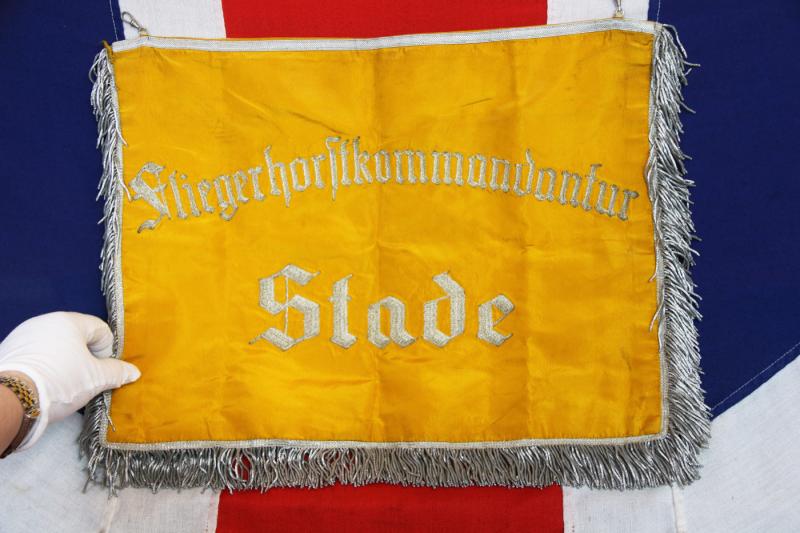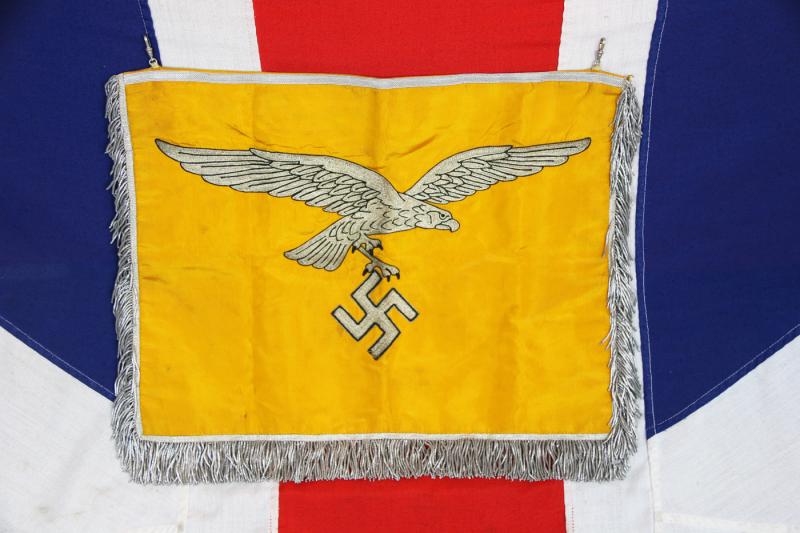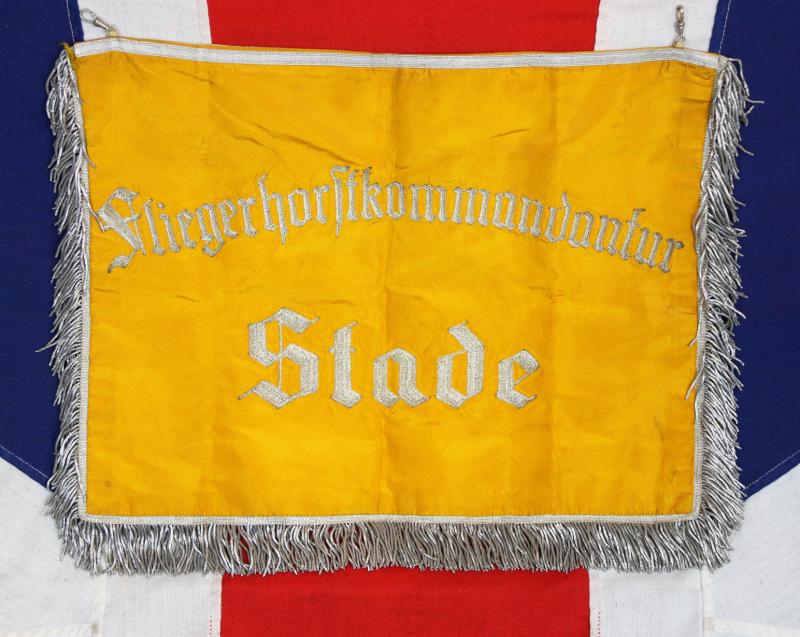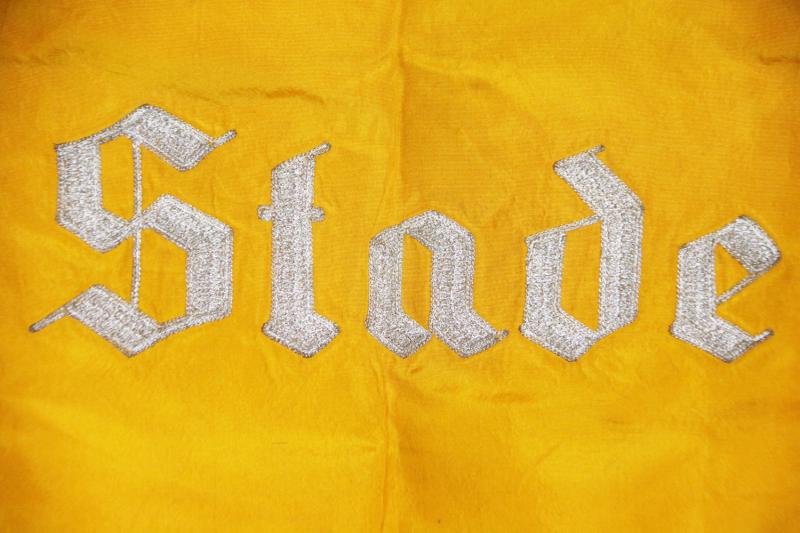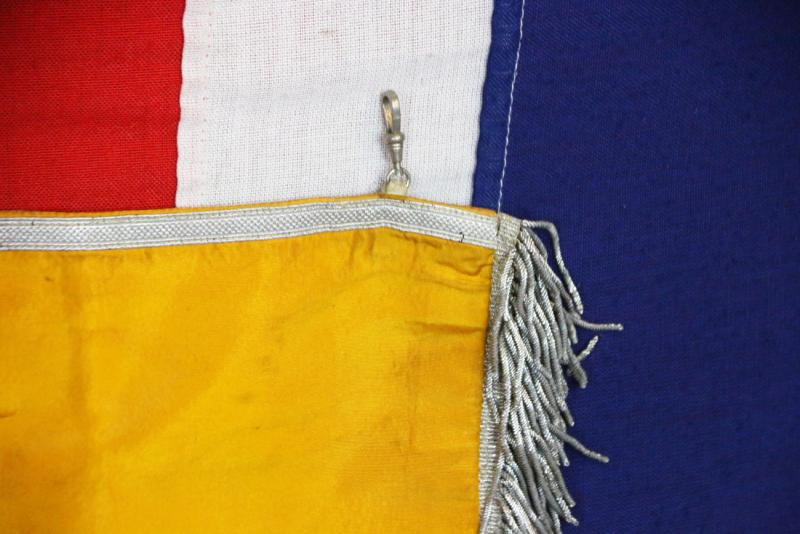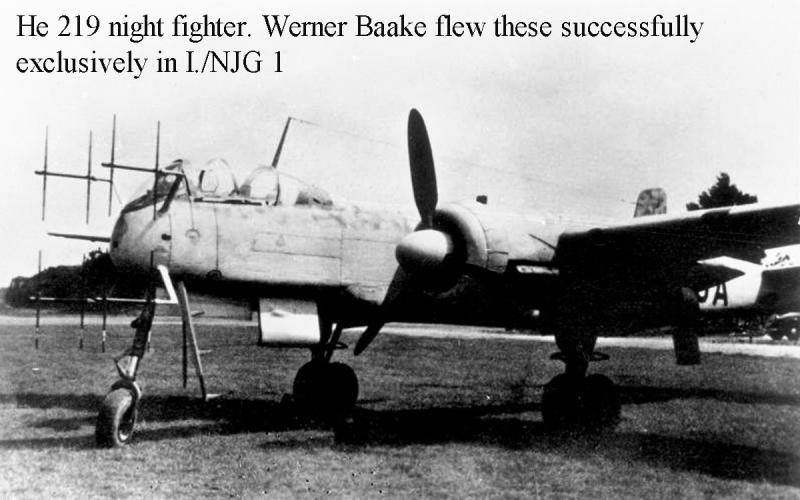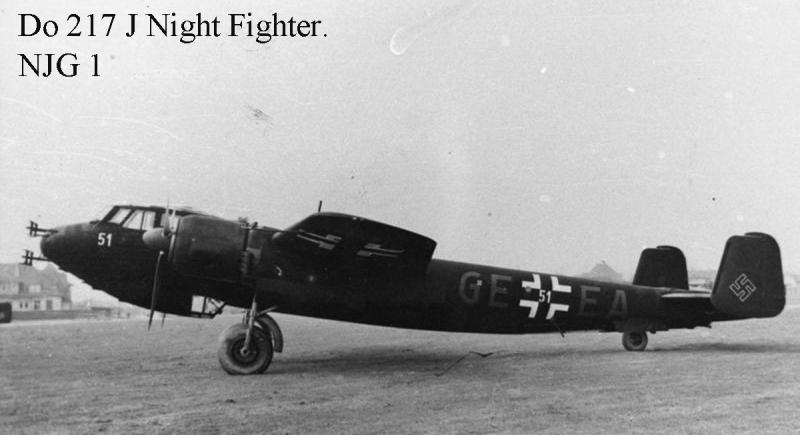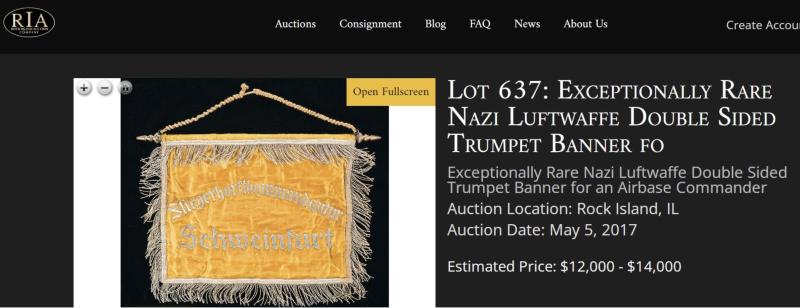Now Sold A Really Rare Original WW2 Luftwaffe Night Fighter Airbase Command Commandant's {Fliegerhorst Kommandantur} of Stade, Double Sided Banner, Of A WW2 Night Fighter Luftwaffe Airbase For Nachtjagdgeschwader 1 {NJG 1} & Nachtjagdgeschwader 3 {NJG 3}
A most worthy candidate as the centrepiece of any, important or significant collection of original WW2 German Third Reich war trophies, captured by allied soldiers at the close of WW2. A representation of all the sacrifices made by the allied armed forces that fought and died to successfully destroy the Third Reich war machine.
Nachtjagdgeschwader 1 (NJG 1) was a German Luftwaffe night fighter-wing of World War II. NJG 1 was formed on 22 June 1940 and comprised four Gruppen (groups). NJG 1 was created as an air defence unit for the Defence of the Reich campaign; an aerial war waged by the Luftwaffe against the bombing of the German Reich by RAF Bomber Command and the United States Air Force. In 1941 airborne radar was introduced with radar operators, and standardised in 1942 and 1943. Consequently, a large number of German night fighter aces existed within NJG 1.
Nachtjagdgeschwader 3 (NJG 3) was a Luftwaffe night fighter-wing of World War II. NJG 3 was formed on 29 September 1941 in Stade from Stab./Zerstörergeschwader 26. Pilots of NJG 3 claimed approximately 820 aerial victories by day and night.
Measuring 19 inches wide and 15 inches tall, both sides of the banner feature yellow fields trimmed in silver ribbon and 2 1/4 inch long silver wire fringe. One side in silver bullion lettering has the text.
Just one of the fighter aces was Oberst Günther Radusch (11 November 1912 – 29 July 1988) was a World War II German Luftwaffe pilot and wing commander. As a fighter ace, he claimed 65 enemy aircraft shot down in over 140 combat missions. He claimed one victory in the Spanish Civil War. During World War II, he was credited with 64 aerial victories in Defense of the Reich all of which claimed at night and includes the destruction of 57 four-engined bombers.
Stade airfield (German: flugplatz Stade or Fliegerhorst Stade) was an airfield 285 west-northwest of Berlin.
It's construction began in the spring of 1935, disguised as a civilian project. The first occupants arrived as early as October 1935 when the first students of the Fliegerersatzabteilung 47 (Pilot Replacement Unit 47) began their course. First use was that of a multi-engine piloting school in 1936 and a second training unit arrived at the airfield in 1937 from Ludwigslust, bringing their Junkers Ju52 and Ju86, Dornier Do17, Focke-Wulf Fw56 and Fw58 aircraft. In 1939 a new large hangar and the first concrete runway (Startbahn II) was built.
After the beginning of the war in 1939, the training units were withdrawn to the east in Brandenburg. In November, they were replaced with night fighters,
In April 1940, air transport aircraft filled with parachutists and mountain troops flew from Stade to begin the occupation of Norway.
In 1941, night-fighters of II./NJG1 were stationed here, making Stade an important part of the defense against Alllied strategic bombers. Although II./NJG1 left after some time, Stade was never really long without nightfigthers after this first prolonged stay. It is during this period that the second runway (Statbahn III) was built. Construction of the Northerly runway ('Startbahn I') was begun, but for unknown reasons it was never completed.
Allied attacks upon Stade;
22 Apr 44: strafed by VIII Fighter Command P-51 Mustangs – claimed 1 x Me 210 and 1 x Ju 88 destroyed, plus 2 x He 111s damaged.
18 Jun 44: bombed by 45 B-24 Liberators. (445th Bomb Group Mission 103 – 45 B-24s dropped 520 x 100 lb. AN-M30 General Purpose bombs)
06 Oct 44: bombed by 29 B-24s.
31 Dec 44: bombed by 13 B-17 Fortresses – 5-6 night fighters destroyed or damaged, 2 hangars burned out and at least one runway cratered.
03 Feb 45: low-level attack by VIII Fighter Command P-51s – claimed 1 x He 111 destroyed and 2 more damaged.
09/10 Apr 45: bombed by 22 RAF Halifaxes and 14 USAAF B-24s in a joint night attack.
18 Apr 45: strafed by RAF Tempests – claimed 2 x Do 217s and 1 x Fw 190 destroyed plus other aircraft damaged. Same date, demolition of the airfield began and unserviceable aircraft destroyed.
01 May 45: occupied by 2nd Battalion Welch Guards.
Stade Operational Units: 10./JG 26 (Nov-Dec 39); Stab/JG 1 (Dec 39 – May 43); II./ZG 1 (Feb 40); I.(Jagd)/LG 2 (Feb-Mar 40); KGr. z.b.V. 104 (Mar-May 40); II./JG 52 (Sep 40); I./JG 27 (Oct 40); II./JG 51 (Oct 40); 3./JG 54 (Oct-Nov 40); Stab/ZG 26 (Sep 41); Stab/NJG 3 (Sep 41 – Apr 45); III./NJG 3 (Nov 41 – Aug 44), II./JG 1 (Feb 42); Luftbeobachterstaffel 2 (Oct 43 - Jun 44); Stab/JG 302 (Nov 43 – Jan 44); III./JG 76 (Jul-Aug 44); I./JG 26 (Apr 45).
School Units: FFS C (twin-engined conversion school) Stade (Nov 37 - Sep 39); Stab and I./Flieger-Ausb.Rgt. 42 (Apr 39 - Jan 40); Bombenschützenvorschule Stade (1940); Flieger-Techn.Schule 2 (1940-43).
Replacement Units: Flieger-Ers.Abt.14 (Oct 35 – Sep 37); Flieger-Ers.Abt.42 (Nov 38 – Mar 39); III./Fallschirmjäger-Ers.-u.Ausb.Rgt. 4 (c.Jan 45 - ? ).
On 18 April 1945 all flyable aircraft were flown to Uetersen, the remainder and the facilities were destroyed. The occupation by the British from 1 May 1945 left some surprises for the British: due to the fast Soviet advance, the commander of the E-Stelle (Erprobungsstelle or "Evaluation Unit") at Werneuchen) was ordered by the Oberkommando dere Luftwaffe (OKL) to evacuate equipment to Stade. As a result, the British discovered amongst others a camouflaged and incomplete Ju-248 V.1 prototype (a reworked Me163 rocket powered interceptor with landing gear instead of a retractable skid) at the airfield.
The Fighter aces of NJG 3;
Helmut Lent
Heinrich Prinz zu Sayn-Wittgenstein
Guenther Radusch
Walter Borchers
Paul Zorner .
Gerhard Raht
Martin Drewes
Werner Hoffmann
Egmont Prinz zur Lippe-Weissenfeld
Hans-Joachim Jabs
Rudolf Frank
Helmut Bergmann
Werner Husemann
Hubert Rauh
Paul Szameitat
Hans Krause
Rudolf Sigmund
Alfons Koster
Alfred Kuhne
Arnold Doring
Reinhold Eckardt
Erhard Peters
Wilhelm Schmale
The closest example of such a historical one as this is one for another airbase commandant that was sold in America in 2017 at RIA est $12,000 to $14,000. That one had its hanging pole, but just like ours, in pretty much identical superb condition, with no damage all braiding present, no fading at all. Both are exactly the same size. See photo 9 in the gallery
RIA Rock Island Auction is the likely most important militaria auctioneers, for the rarest of all forms of militaria, in the US, if not the world.
Code: 25832

